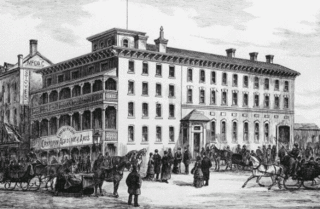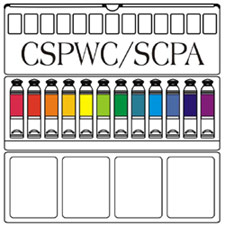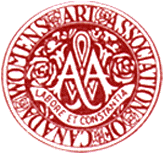Related Research Articles
Maxwell Bates LL.D was an architect and expressionist painter.

The Royal Canadian Academy of Arts (RCA) is a Canadian arts-related organization that was founded in 1880.

Charles Fraser Comfort, LL. D. was a Scottish-born Canadian painter, sculptor, teacher, writer and administrator.

The Canadian Society of Painters in Water Colour, founded in 1925, is considered to be Canada's official national watercolour Society. Since the 1980s the Society has enjoyed Vice-regal Patronage from the incumbent Governor-General of Canada. Recognized by a long list of international exhibitions it is the Canadian equivalent of such other national societies as the American Watercolor Society of the United States, the Royal Watercolour Society of the United Kingdom, etc.

Charles William Jefferys who signed his name C. W. Jefferys was an English-born Canadian artist, author and teacher best known for his historical illustrations.
Sylvia Tait is a Canadian abstract painter and printmaker.

Margaret Dorothy Shelton (1915–1984) was a Canadian artist who lived nearly all of her life in Alberta. She worked in a number of mediums but is best known for her block printing.
Vanguard was a periodical produced in Vancouver, British Columbia, Canada from 1972 to 1989, containing reviews and critical articles on Canadian art and artists. The magazine was successor to the Vancouver Art Gallery Bulletin which existed between 1933 and 1971. It was published monthly by the Vancouver Art Gallery from 1972 to 1984. The first issue of Vanguard appeared in January 1972. In February 1979 it was redesigned as a glossy, full format, perfect-bound, magazine with full-color photographs of artwork featuring longer articles, usually on individual artists, in front, and short, illustrated, reviews of current exhibitions in Canada in back. Its coverage also expanded to include national art events. Canadian arts writers were featured along with three American art critics: Donald Kuspit, Erik ReeL, and Matthew Kangas. The magazine was published by the Vancouver Society for Critical Arts Publications from 1985 to 1989, when it ceased publication. Full holdings can be found at the Vancouver Art Gallery library.

Dorothy Stevens was a Canadian etcher, portrait painter, printmaker, illustrator and teacher, perhaps the most accomplished Canadian etcher of her day. She is known for the prints she made of factory workers during World War I. She exhibited in Canada, the United States, England and France.

The Women's Art Association of Canada (WAAC) is an organization founded in 1887 to promote and support women artists and craftswomen in Canada, including artists in the visual media, performance artists and writers. At one time, it had almost 1,000 members. Although smaller today, it still plays an active role in fundraising and providing scholarships for young artists.
Lily Osman Adams (1865–1945) was a Canadian painter. She worked mainly in pastel and watercolor, and depicted landscapes, flowers and still life.
The Canadian Handicrafts Guild was an association of Canadians involved in handicrafts that was founded in Montreal in 1906. At first the goal was to preserve and market traditional home crafts that were seen as being at risk of dying out. Demand for high quality products and a shift towards more "professional" craftspeople and modern designs placed stress on the organization. In 1967 the provincial branches became autonomous, and subsequently evolved separately. At the national level the Guild was merged with the Canadian Craftsman's Association in 1974 to form the Canadian Crafts Council, now the Canadian Crafts Federation.
Albert Edward Cloutier (1902–1965) was a Canadian painter and graphic designer who painted in a form of intensified realism with abstract plastic forms.
The Canadian Guild of Potters was a non-profit organization of Canadian ceramic artists that was active from 1936 to 1978.
The Society of Canadian Painter-Etchers and Engravers (CPE) was a non-profit organization of Canadian etchers and engravers.
The Federation of Canadian Artists (FCA) is an association of artists in Canada founded in Toronto in 1941. The FCA soon had chapters across the country, and was one of the main forces behind formation of the Canada Council in 1957. After this, the national organization withered, and only the British Columbia chapter remained active. A drive for expansion began in 1977, causing a renewal of activity that started in western Canada and then spread. Expansion stalled out in the late 1990s when funding cuts hit the Federation as hard as it hit other arts organization. Renewed vigor by volunteers and staff in recent years has brought new life to the Federation and expansion is again underway. The organization has about 2,700 paying members and 5,000 artist contacts throughout Canada as of the end of 2017, a permanent gallery in Vancouver, and organizes approximately 44 exhibitions every year.

Wynona Croft Mulcaster was a Canadian painter and teacher from Saskatchewan, best known for her prairie landscapes. She also played an important role in developing competitive riding in Saskatoon.
Albert Jacques Franck was a Canadian artist. He is known for his realistic paintings of Toronto winter scenes, dilapidated neighbourhoods and back lanes. His detailed paintings provide a historical record of conditions in some of Toronto's once less affluent neighbourhoods.

Charles Macdonald Manly who signed his name C. M. Manly was a lithographer, painter, sketcher and educator in the early days of Canadian art.
The Toronto Art Students' League (TASL) or the Toronto Art League as it was called from 1899 on was an association of artists that existed from 1886 to 1904 and advocated drawing from the antique, and drawing and painting from life as a key to making art. It was a way of circulating recent art developments such as the Arts & Crafts movement and Art Nouveau as well as serving as a training ground and as a way of providing encouragement and fellowship for younger artists. It met about once a week to produce drawings from life and its operative mottos were the disciplinary "Nulla Dies Sine Linea" and "Non Clamor Sed Amor".
References
Citations
- ↑ Lerner & Williamson 1991, p. 100.
- ↑ Belton 2001, p. 95.
- 1 2 3 4 Lerner & Williamson 1991, p. 101.
- ↑ Lerner & Williamson 1991, p. 208.
- ↑ Belton 2001, p. 97.
- ↑ Belton 2001, p. 99.
- ↑ Cochran 1989, p. 3.
- ↑ Belton 2001, p. 45.
- ↑ Lacroix, Laurier. "Canadian Artists' Organizations". www.thecanadianencyclopedia.ca. Canadian Encyclopedia. Retrieved 30 August 2022.
- ↑ Lerner & Williamson 1991, p. 49.
- ↑ Lerner & Williamson 1991, p. 53.
- ↑ Lerner & Williamson 1991, p. 105.
- ↑ Belton 2001, p. 106.
Sources
- Belton, Robert James (2001). Sights of Resistance: Approaches to Canadian Visual Culture. University of Calgary Press. ISBN 978-1-55238-011-6 . Retrieved 2014-07-24.
- Cochran, Bente Roed (1989-01-01). Printmaking in Alberta, 1945–1985 . University of Alberta. p. 3. ISBN 978-0-88864-139-7 . Retrieved 2014-07-23.
- Lerner, Loren R.; Williamson, Mary F. (1991-01-01). Art and Architecture in Canada: A Bibliography and Guide to the Literature. University of Toronto Press. ISBN 978-0-8020-5856-0 . Retrieved 2014-07-23.